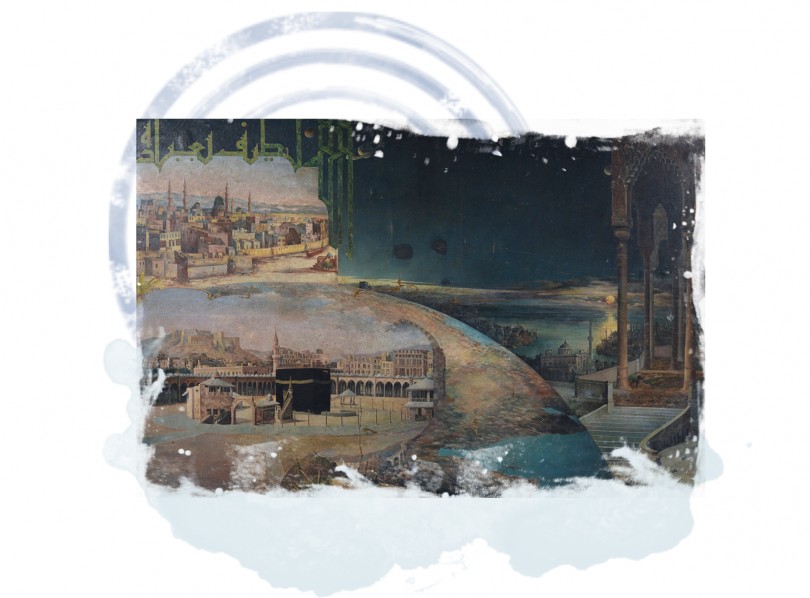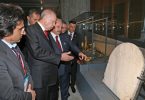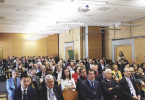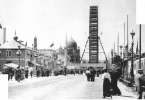For years, a weathered painting hung on one of the elephant foot columns of the Fatih Mosque. After a Friday prayer in the mosque, President Abdullah Gül somehow noticed the painting while touring the mosque, and after a closer look, he realized that it depicted Ottoman Empire’s outlook on the world and its description of the universe. In the foreground, the painter had placed Mecca and Medina at the center of the globe representing the Earth, and had wreathed Medina with some kufic script. On the right was the entrance to the Yıldız Palace, and in the background were smaller depictions of Mecca and Medina, and a silhouette of İstanbul with domes and minarets, Hamidiye Mosque, and planets in the sky. Upon careful inspection, right at the bottom of Mecca’s portrayal, it was possible to
see the Hicaz railroad complete with its bridges and tunnels. Obviously, the painter meant to convey the message
that the caliph emperor at the center of the caliphate was obliged to serve Mecca and Medina. On the left bottom corner, in delightful taʿlīq script, the date and signature were thus recorded:
“27 Ramazan ul Mubarak 1323 (25 November 1905), Grand Directorate of Religious Affairs Office Scribe Memarzadeh Mehmed Ali.”
If the script in this notice was by his own hand, Memarzadeh must have also been an apt taʿlīq calligrapher; in which case the first thing to do was to consult Ibnul Amin Mahmud Kamal’s book ‘The Last Calligraphers’.
Surprised by this discovery, President Abdullah Gül inspected the painting closely and realized that both the painting and the frame were in extremely bad condition; upon which he ordered the inclusion of the painting in a restoration
program along with other works from the Presidential Palace. Following extensive research, the Palace’s art advisor at the time, Ömer Faruk Şerifoğlu, prepared a report and got the permission of the Directorate General of Foundations to ship the painting to the Çankaya Palace to be carefully restored.
As told in ‘The Last Calligraphers’, Memarzadeh Mehmed Ali Bey, born 1879, was the first son of Builder Mehmed Effendi. He finished his primary and secondary education in Bolu. After moving to İstanbul, he enrolled in the Academy of Fine Arts, graduating from the Department of Architecture in 1912. Meanwhile, he practiced calligraphy with Çarşambalı Ahmed Hamdi Effendi and received a certification. He was appointed second degree scribe at the Office of the Shaykh al-Islām Secretariat, and a calligraphy professor at the İstanbul Madrasa. For a time, he was exiled to Sinop by the Unionists for being an Accordist. Upon his return, he taught painting and calligraphy at schools. During the period when his father-in-law Mustafa Sabri Effendi was Shaykh al-Islām, he became the Director of Turkish and Islamic Arts Museum and the Madrasa of Calligraphy.
After the War of Independence was won, he fled with his father-in-law to Romania, and then to Egypt. He worked as a painter and calligrapher at the Printworks of Egypt, and taught painting and calligraphy at a school founded by King Fuad I.
The second time Ibnul Amin went to Egypt following an invitation, he learned that Memarzadeh had passed away in a tram accident (16 January, 1938). He was deeply saddened by this. When remarking on the importance of this valuable artist in calligraphy and painting, Ibnul Amin writes that “Memarzadeh had discovered something of a new
form of calligraphy mixed with painting,” after which he pens this interesting passage:
“What discoveries he would make as a most talented man with a wide imagination. A painting in which he depicted both the divine and the mundane world was displayed for a long time on the shop window of a furrier in the Grand Bazaar. What forms, what words were in that painting one cannot express neither with forms nor words. In answer to the late Bahayî’s question, You illustrate beautifully the lover’s shape and countenance but What to do as we come to enchantment and enticement ye Behzād he would answer before Behzād, illustrating even ‘enchantment and
enticement’.”
Zekai Konrapa in ‘History of Bolu’ depicts Mehmed Ali Effendi in freshman painting classes at the Bolu High School, and describes him as an intellectual who has managed to combine a madrasa degree with the knowledge of schools, and a powerful painter and calligrapher adept at all the Arabic forms. Konpara informs us that the plaques decorating the walls of the Bayezid I and İmaret Mosques are of Memarzadeh’s works; and especially praises the
painting at the muezzin mahfil of the Fatih Mosque as a unique work of art holding deep meanings, which he goes on to interpret. Unfortunately, we do not know the whereabouts of the paintings mentioned by Ibnul Amin and Zekai Konpara. Ibnul Amin in ‘The Last Calligraphers’, upon failing to find a calligraphy sample by Memarzadeh, had to
use the artist’s logo design for the ‘Beyanülhak’ magazine consisting of both graphics and letters.
Due to the circumstances of the times and his father-in-law’s enlistment in the 150 personae non gratae of Turkey, Mamerzadeh lived and died away from his country, and was left out of art history books. We therefore do not know which art form he was first interested in. It might be that he was first interested in calligraphy because it is an art form leaning on a deep rooted tradition. In our art history, there are other calligraphers interested in painting. The great 19th century calligrapher Mustafa Râkim, known for perfecting the tughra form, had painted a portrait of Selim
III and was rewarded for it. Kazasker Mustafa İzzet’s student Abdullah Zühdî was a painter, too. Tughrakesh
İsmail Hakkı Altunbezer was one of the first graduates of the Academy of Fine Arts, and would make great paintings in the academic style. It is known that Halim Özyazıcı, Macid Ayral, and Hâmid Aytaç made good paintings.
The sons of the calligraphers have their prominent places in Turkish painting. Namık İsmail’s father İsmail Zühdî Effendi was a master of Naskh and Thuluth scripts. I don’t know of Chief Calligrapher Hajji Kâmil Akdik’s relationship with painting, but his son Şeref Akdik is an important painter and calligrapher certified by his father. Painter and sculptor Zühtü Müridoğlu’s brother Hafiz Kemal Batanay is a great calligrapher, composer, and tanburi.
Painters interested in calligraphy are a separate case:
Osman Hamdi and Şevket Dağ have depicted calligraphic plates in their paintings with the meticulousness of calligraphers. Hoca Ali Rıza liked writing kufic tiles, and his sketchbook includes both kufic tiles and pleasant
ta l q script. The portrait artist Feyhaman Duran—although never certified—has practiced with strong calligraphers like Sami Effendi and has dabbled in this art until the end of his life; had a rich calligraphy collection, and had painted portraits of calligraphers like Kâmil Akdik. Rıfat Effendi, and Hajji Yahya Hilmi Effendi. İbrahim Çallı was another painter interested in calligraphy; his interest is clearly visible in his series “The Mevlevis”. Showing great care for calligraphy during his directorship of the Turkish and Islamic Arts Museum, Elif Naci used old letters as key components of composition in some of his paintings. As a matter of fact, Elif Naci claimed that he was the first painter to use Islamic calligraphy in this sense.
It should not be ignored that one of our first female painters, Melek Celâl Sofu, had special interest in the art of calligraphy. I confine myself to only mentioning her books ‘Chief Calligraher Kâmil Akdik’ (1938) and ‘Sheik Hamdullah’ (1949). It is rumored that she has unpublished works on İsmail Hakkı Altunbezer and Necmeddin
Okyay. One of the greatest names of Turkish watercolor painting, Malik Aksel, was particularly interested in calligraphy that is shaped to resemble objects. His work ‘Religious Paintings in Turks’ (1967) still retains its importance.
Most of the modern Turkish painters turn to the art of calligraphy after realizing Western painters like Picasso, Paul Klee, Kandinsky, and Hans Hartung were interested in this art form. Calligraphy was reflected in different ways and perceptions in the works of painters like Cevat Dereli, Bedri Rahmi Eyüboğlu, Nurullah Berk, Sabri Berkel, Şemsi
Arel, Abidin Dino, Adnan Çoker, Erol Akyavaş, Süleyman Saim Tekcan, and Ergin İnan. Abidin Dino was especially taken by the art of calligraphy and at times called himself a calligrapher. In a writing on his life, he says that one of his neighbour was a great calligrapher, which influenced his interest in calligraphy and miniature at an early age.
As for Erol Akyavaş… The treatment of Akyavaş, which makes the abstract plastic value of the art of calligraphy an inseparable part of his painting, has more importance and meaning than to be glossed over in an article such as this. Despite the alienating and irresistible pressure of modernism, what Akyavaş wanted to do, by trying to make the
indispensable value of tradition a part of our lives, was rarely found in our history of modernization. He reread Tasawwuf, which also determines the aesthetic preferences of the world from which we come, by using the tools and means of modern painting. This attempt has a most important place in the art of calligraphy.









Leave a Comment